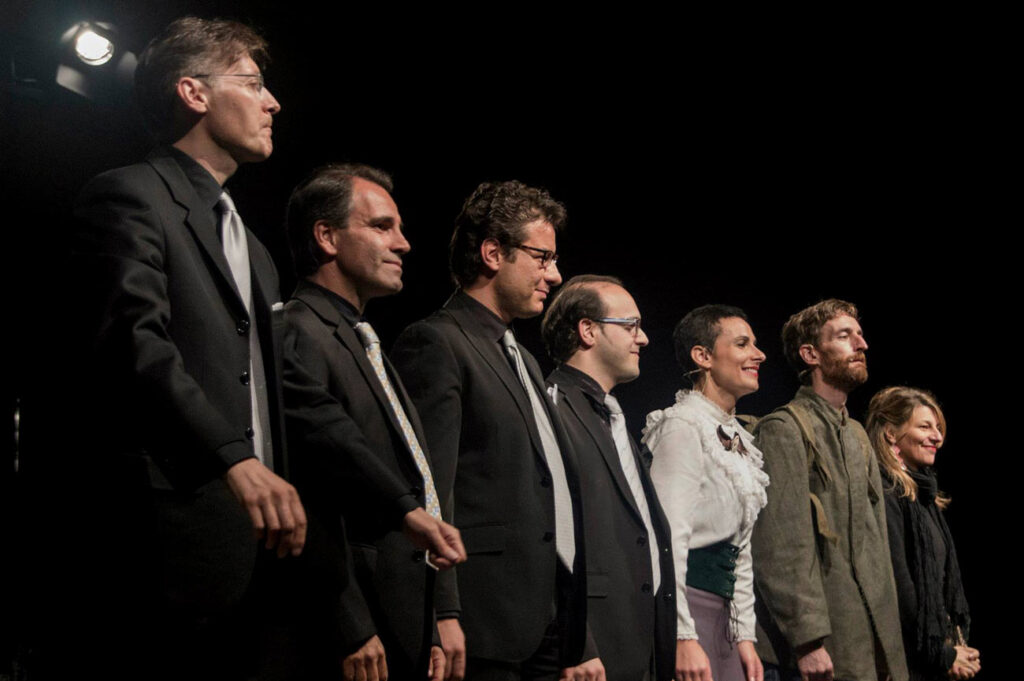The show begins with snapshots of the cultural and social life of Europe which is on its way to self-destruction. On New Year’s Eve 1914 the noise of the corks echoed tragically referring to what would be the shooting of Sarajevo. The color cover of Domenica del Corriere, illustrating the attack, lights up on a screen. In the image, Archduke Franz Ferdinand, heir to the throne of Austria-Hungary and his wife Sofia, shot to death by a Serbian student’s gun. Newspapers from all over Europe spread the news. In the cities there is chaos, you see Vienna, London, Paris, Rome, people reading the newspapers, heads of state, diplomacy at work. Over these images, a voice: “I deplore this bloody event” says the French ambassador in Vienna “But I know that the fact will ensure peace in Europe for more than half a century”. Suddenly, front pages of newspapers in all languages announcing Austria’s declaration of war on Serbia and the subsequent involvement of Russia, Germany, France and England in the conflict. The black and white of the images then shows the first movements of troops, some soldiers smiling, others embracing each other, at a station people greet those leaving for the front. On these images, the same voice: “You will return to your homes before the leaves have fallen from the trees” says Kaiser Wilhelm II to the German troops. It is August 1914. After four years, more than 9 million soldiers and about 7 million civilians will have died: it is the 1st World War that history will call
Images
The singer and the musicians have the task of restoring the atmosphere of such a particular era, crossed by melodic songs and avant-garde notes. In the general mobilization of the 29 countries involved in the conflict, many musicians appeared, coming from the most varied musical cultures. The program includes author music alongside popular songs collected in the Italian trenches. Opening with an Allegretto composed on the front line of the Karst on Christmas night 1916 by Captain Giuseppe Denti, also author of the Waltz written in prison in Rastatt in November 1917, after Caporetto. This is followed by a Song by Gershwin, an American composer extremely influenced by European authors and who experienced the horror of the First World War firsthand, to which he reacted by composing some of the most carefree music of the 1900s. Among the French soldier-musicians is Maurice Ravel, who in those years wrote Tombeau de Couperin for piano and the Trois chansons for a capella choir, performed here in an original version: each piece of this work is dedicated to a comrade who died in war. Also from the French sphere is the piece by Claude Debussy from 1915, Noël des enfants qui n’ont plus de maison. The German Paul Hindemith will perform Mélancholie for voice and ensemble, composed for notes in 1917 during his military service and definitively developed in 1919, just after the war. The dedication of this touching piece divided into four lieder, on texts by Christian Morgensen, is to Karl Kohler, a comrade who died in combat in 1918. Arnold Schöenberg, departed a volunteer for the front in 1916, he composed Der eiserne Brigade, a singular and ironic march with trio for strings, piano and “animals” in tonal style, where it is not difficult to perceive how little the Austrian musician had to do with that environment and that world. In the program there are also 3 of the most beautiful songs of the Great War where we find the themes of the uncertainty of the future and the awareness of near death (Monte Canino), the terrible description of the battle (La Leggenda del Piave), finally the repudiation of the war
ra (Gorizia). Alongside these classics, the arrangements and original music composed by Giuliano Di Giuseppe.

The artists
Stefano Scherini – actor
Patrizia Cigna – voice
Zoltan Banfalvi – violin
Pierluigi Ruggiero – cello
Luca Trabucchi – guitar
Giuliano Di Giuseppe – piano
Dramaturgy by Giovanna Scardoni
Video production by See Mars – Video & Animation Studio
Compositions and musical adaptations by Giuliano Di Giuseppe
Lighting design by Anna Merlo
Directed by Stefano Scherini
Discover more
Original music and arrangements
Giuliano Di Giuseppe



